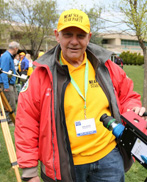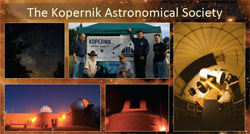 The following article has been provided by Barlow Bob, founder & organizer of the NEAF Solar Star Party and regional event host & lecturer. Bob will be attending Kopernik AstroFest hosting the Kopernik AstroFest Solar Star Party October 4th – 5th, and will perform demonstrations of safe solar observing techniques including solar spectroscopy.
The following article has been provided by Barlow Bob, founder & organizer of the NEAF Solar Star Party and regional event host & lecturer. Bob will be attending Kopernik AstroFest hosting the Kopernik AstroFest Solar Star Party October 4th – 5th, and will perform demonstrations of safe solar observing techniques including solar spectroscopy.
You can read more about Barlow Bob and see some of his other articles at www.neafsolar.com/barlowbob.html.
THE SOLAR SPECTROSCOPY PROJECT
By Barlow Bob
Most solar amateur astronomers observe sunspots on the surface of the Sun, through a white light solar filter. Some also observe prominences and other features above the surface of the Sun, through a Hydrogen-Alpha solar filter. If you are an amateur solar astronomer, who shares your safe solar telescope at educational outreach events, please consider including solar spectroscopy at these events.
You do not have to make an expensive investment, to purchase a solar spectroscope or spectrometer. Science First www.sciencefirst.com and Edmund Scientificwww.scientificsonline.com both sell several inexpensive types of low resolution spectroscopes and spectrometers under $40.00.
A spectroscope is an instrument for producing and examining spectra.
This produces spectra of visual electromagnetic radiation. A spectrometer is an instrument for dispersing electromagnetic radiation and analyzing the location of the spectrum lines. A spectrograph is an instrument for dispersing electromagnetic radiation and recording the spectrum.
These spectroscopy products are all easy to use. Laminate an 8 ½ by 11 inch sheet of white paper. Place this laminated sheet on a table next to your solar telescope. Point the spectroscope down at the sheet of paper. Sunlight reflected off of the laminated sheet enters the front of the spectroscope to the grating or prism. You observe the dark Fraunhofer lines of the solar absorption spectrum. These are thin vertical dark lines in the horizontal colors from red to violet.
Turn a cardboard carton on its side and put it on a table next to your solar telescope. Place a lighted camp lantern with florescent bulbs inside the carton. You can see the lighted lantern better in bright sunlight. Observe the emission spectra of the element mercury inside of the florescent bulb. You can use this demonstration to explain how astronomers discovered what the dark Fraunhofer lines were in the solar spectrum.
You can allow people to observe the dark absorption lines of the solar spectrum through a spectroscope. They can compare these dark absorption lines to the bright emission lines of the florescent light bulb.
The gas in the interior of a star like the Sun is under high pressure. The gas in the outer atmosphere of the Sun is under lower pressure. A photon piece of light moves from the interior to the surface of the Sun and passes through the outer atmosphere. When it passes through the outer layer of the Sun this outer layer absorbs the wavelengths of the specific elements in this outer layer. The remaining light passes through. The spectrum of the elements in the outer layer appears as dark vertical lines in the spectroscope.
In 1802, William Hyde Wollaston (1766 – 1828), an English Chemist and Physicist, discovered the spectrum of sunlight is crossed by a number of dark lines. This was the birth of solar spectroscopy.
In 1814, Joseph Von Fraunhofer (1787 – 1826) a German glassmaker rediscovered the dark lines in the solar spectrum noted by William Hyde Wollaston and determined their position with improved precision. He made careful measurements of over 500 dark lines in the Sun’s spectrum. He never tried to find out what the lines were or where they came from. Today we honor his careful bench mark investigations by referring to these dark absorption lines of this type as Fraunhofer lines.
Fraunhofer needed a way to measure small differences in the composition of his glass from one melt to another. When white light comes into the prism, the different wavelengths are bent through different angles, resulting in a spread of colors.
Prisms made of slightly different pieces of glass, will bend the same wavelength of light through different angles. He needed some sort of calibration standard. He used a series of dark bands superimposed at regular intervals over the colored spectrum of light to solve his calibration problem. However he had no idea what these lines were.
In 1959 Germans Gustav Robert Kirchoff (1824 – 87), a physicist and Robert Bunsen (1811 – 99 ), a chemist observed the bright emission spectrum lines of different heated elements through a prism spectrometer. They discovered that dark Fraunhofer lines appeared, when they observed the light from a fire in their city through smoke. When they compared the dark absorption spectra lines to the bright emission spectra lines in their laboratory, they realized that they discovered that they now had a way to analyze the chemical elements by observing the dark Fraunhofer absorption lines. This was the start of astrophysics to analyze stars.
Kirchoff studied light spectra using the spectrometer he developed with Bunsen. He observed that individual atoms and molecules emit certain colors when heated. Kirchoff realized that each element produces a distinct spectrum of colored emission lines that can be used to identify the element.
Kirchoff and Bunsen observed the light from a distant fire through their spectrometer. They observed dark Fraunhofer absorption lines of light from the fire passed through smoke. They noticed that these dark absorption lines appeared in the same location as the bright emission lines of elements they observed in their laboratory.
In 1861, Bunsen and Kirchoff performed experiments leading to the conclusion that the dark lines in the solar spectrum, observed by Wollaston and Fraunhofer, arise due to the absorption of light by gases in the solar atmosphere that are cooler than those emitting the light.
In 1872, Henry Draper, a wealthy American physician and amateur astronomer was the first person to photograph the Fraunhofer absorption spectrum of a star. He used a prism spectrograph. This introduced the world, to a powerful tool for probing the physical properties of stars. For the first time the Henry Draper (HD) Catalogue, data was available as an astronomy research resource.
When Henry Draper died in 1882, his widow Anna Parker Draper funded the
HD catalogue. Edward C. Pickering, the Harvard College Observatory director continued creating Henry Draper’s catalogue. The woman called computers at Harvard College examined the spectra of thousands of stars in these photographic plates. They noticed that the series of dark Fraunhofer lines of red stars had a similar pattern. Other star colors each had similar dark line patterns. These women created the OBAFGKM system to organize this catalogue of star spectra. These computers worked seven hour days for six days a week and were paid 25 cents per hour. For these women, the opportunity to contribute to science was more important than the salary. By the middle of the 20th century, Henry Draper’s namesake catalogue would contain position and spectral information for nearly a quarter of a million stars.
Spectroscopy is still used today. Astronomers use spectroscopy today to analyze the finger prints of stars and other celestial objects. Manufacturers of food, drug and chemical products use spectroscopy to analyze the quality of their products. Government agencies including the FBI, FDA and OSHA also use spectroscopy for analysis.
You can allow people to observe the dark absorption Fraunhofer lines of the solar spectrum through the spectroscope. The allow them to observe the bright emission lines of elements in the florescent light bulb in the camp lantern. These two observations can be used to explain how astronomers use spectroscopy to analyze starlight.
You do not have to wait until sunrise to do solar spectroscopy. You can observe the solar spectrum reflected off of the Full Moon at midnight. You can recreate how Fraunhofer, Kirchoff and Bunsen discovered absorption and emission spectra for kids of all ages.
This could be someone’s science fair project.
© 2013 Barlow Bob






